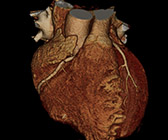Coronary CTA
| Q: What is Coronary CTA? |
| Q: Who should consider having a Coronary CTA? |
| Q: What are some of the risk factors for CAD? |
| Q: Will my insurance pay for this exam? |
| Q: Do I need to have X-ray dye (contrast)? |
| Q: How can I find out more about Coronary CTA? |
CT Angiography (CTA) uses x-rays to visualize blood flow in vessels throughout the body – from those serving the brain to those bringing blood to the heart, lungs, kidneys, arms, and legs. Compared to traditional catheter angiography, which involves injecting contrast material directly into an artery, CTA is much less invasive and more patient-friendly. It can also be far more cost effective. As part of the exam, you’re positioned on a CT scan table and contrast is injected into a vein. Then, a special state-of-the-art, high-speed scanner captures hundreds of cross-sectional images. Afterwards, a powerful computer reconstructs a series of 3D images that our radiologists can view from any angle. Not only is this technique invaluable for delineation of the body’s vasculature, but it is also relatively safe, convenient, and non-invasive. Who should consider having a Coronary CTA? Coronary Artery Disease (CAD) is the single leading cause of death in the United States. While heart attacks occur in 1.2 million Americans every year, for 150,000 individuals, the first sign of coronary disease is sudden death. Coronary CTA may be appropriate for:
What are some of the risk factors for CAD? Family history of heart disease
Will my insurance pay for this exam? Medicare and most 3 rd party providers will cover this exam if patients have a history of chest pain or known coronary artery disease. Studies performed on high risk patients that are not symptomatic are considered “screening” and are not generally covered by insurance. These patients can obtain a referral from their primary care physician but, they must pay for the procedure “out of pocket”. Do I need to have X-ray dye (contrast)? Yes. This study requires X-ray dye to be injected through a small I.V. in the arm. This dye allows the inside of the coronary arteries to be visualized. A small percentage of patients (less than 1 in 2000) have an allergic reaction to the dye. Our radiologists are prepared to treat these rare situations. How can I find out more about Coronary CTA? Call our office at (610)-579-3500 to find out more about how to schedule this exam. You should consult your regular physician immediately if you are currently experiencing any symptoms of heart disease (chest pain or difficulty breathing). |



